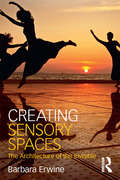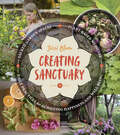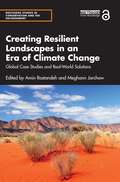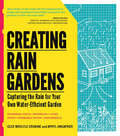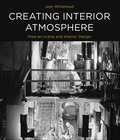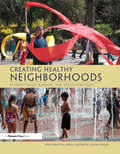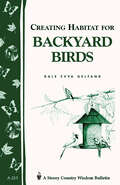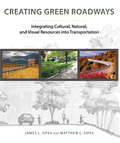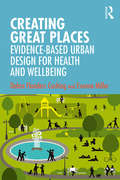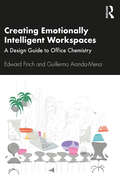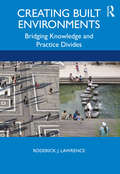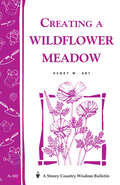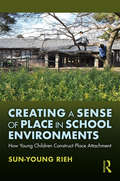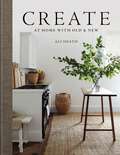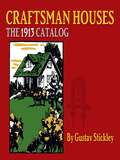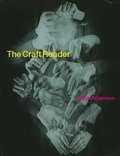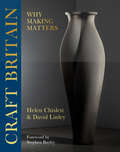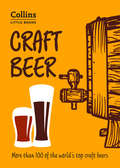- Table View
- List View
Creating Sensory Spaces: The Architecture of the Invisible
by Barbara ErwineCreating Sensory Spaces celebrates spaces enlivened with sensual richness and provides you with the knowledge and tools necessary to create them. Drawing on numerous built case studies in ten countries and illustrated with over 85 full color images, the book presents a new framework for the design of sensory spaces including light, color, temperature, smell, sound, and touch. Bridging across disciplines of architecture, engineering, phenomenology and perceptual psychology, this book informs the design of buildings and neighborhoods that reclaim the role of the body and all the senses in creating memorable experiences of place and belonging.
Creating Sensory Spaces: The Architecture of the Invisible
by Barbara ErwineCreating Sensory Spaces celebrates spaces enlivened with sensual richness and provides you with the knowledge and tools necessary to create them. Drawing on numerous built case studies in ten countries and illustrated with over 85 full color images, the book presents a new framework for the design of sensory spaces including light, color, temperature, smell, sound, and touch. Bridging across disciplines of architecture, engineering, phenomenology and perceptual psychology, this book informs the design of buildings and neighborhoods that reclaim the role of the body and all the senses in creating memorable experiences of place and belonging.
Creating Sanctuary: Sacred Garden Spaces, Plant-Based Medicine, and Daily Practices to Achieve Happiness and Well-Being
by Jessi BloomIn this uplifting guide, bestselling author Jessi Bloom inspires you to turn any outdoor space, from a small balcony to a large garden, into a personal sanctuary for health and wellness.
Creating Resilient Landscapes in an Era of Climate Change: Global Case Studies and Real-World Solutions (Routledge Studies in Conservation and the Environment)
by Amin Rastandeh Meghann JarchowThis book delivers a realistic and feasible framework for creating resilient landscapes in an era of anthropogenic climate change. From across six continents, this book presents fifteen case studies of differing sociocultural, economic, and biophysical backgrounds that showcase opportunities and limitations for creating resilient landscapes throughout the world. The potential to create socio-ecological resilience is examined across a wide range of landscapes, including agricultural, island, forest, coastal, and urban landscapes, across sixteen countries: Argentina, Australia, Brazil, Denmark, Finland, Greece, Guatemala, Japan, Mexico, Norway, Samoa, South Africa, the United States, Turkey, Uruguay, and Vanuatu. Chapters discuss current and future issues around creating a sustainable food system, conserving biodiversity, and climate change adaptation and resilience, with green infrastructure, nature-based architecture, green-tech, and ecosystem services as just a few of the approaches discussed. The book emphasizes solution-oriented approaches for an "ecological hope" that can support landscape resiliency in this chaotic era, and the chapters consider the importance of envisioning an unpredictable future with numerous uncertainties. In this context, the key focus is on how we all can tackle the intertwined impacts of climate change, biodiversity loss, and large-scale land-cover conversion in urban and non-urban landscapes, with particular attention to the concept of landscape resiliency. The volume provides that much-needed link between theory and practice to deliver forward-thinking, practical solutions. This book will be of great interest to students, researchers, practitioners and policymakers who are interested in the complex relationship between landscapes, climate change, biodiversity loss, and land-based conversion at local, national and global scales.
Creating Resilient Landscapes in an Era of Climate Change: Global Case Studies and Real-World Solutions (Routledge Studies in Conservation and the Environment)
by Amin Rastandeh Meghann JarchowThis book delivers a realistic and feasible framework for creating resilient landscapes in an era of anthropogenic climate change. From across six continents, this book presents fifteen case studies of differing sociocultural, economic, and biophysical backgrounds that showcase opportunities and limitations for creating resilient landscapes throughout the world. The potential to create socio-ecological resilience is examined across a wide range of landscapes, including agricultural, island, forest, coastal, and urban landscapes, across sixteen countries: Argentina, Australia, Brazil, Denmark, Finland, Greece, Guatemala, Japan, Mexico, Norway, Samoa, South Africa, the United States, Turkey, Uruguay, and Vanuatu. Chapters discuss current and future issues around creating a sustainable food system, conserving biodiversity, and climate change adaptation and resilience, with green infrastructure, nature-based architecture, green-tech, and ecosystem services as just a few of the approaches discussed. The book emphasizes solution-oriented approaches for an "ecological hope" that can support landscape resiliency in this chaotic era, and the chapters consider the importance of envisioning an unpredictable future with numerous uncertainties. In this context, the key focus is on how we all can tackle the intertwined impacts of climate change, biodiversity loss, and large-scale land-cover conversion in urban and non-urban landscapes, with particular attention to the concept of landscape resiliency. The volume provides that much-needed link between theory and practice to deliver forward-thinking, practical solutions. This book will be of great interest to students, researchers, practitioners and policymakers who are interested in the complex relationship between landscapes, climate change, biodiversity loss, and land-based conversion at local, national and global scales.
Creating Rain Gardens: Capturing the Rain for Your Own Water-Efficient Garden
by Apryl Uncapher Cleo Woelfle-Erskine&“A beautifully-written, practical guide to planning and creating your own rain garden.&” —Green Upgrader You probably spend hundreds of dollars watering your yard, but there is an easy way to save money and resources—by collecting rain to reuse in front and backyards. In Creating Rain Gardens, water conservation experts Cleo Woelfle-Erskine and Apryl Uncapher walk you through the entire process, with step-by-step instructions for designing and building swales, French drains, rain gardens, and ephemeral ponds. From soil preparation, planting, troubleshooting, and maintenance, to selecting palettes of water-loving plants that provide four-season interest and a habitat for wildlife, Creating Rain Gardens covers everything you need to create a beautiful rain garden at home.
Creating Interior Atmosphere: Mise-en-scène and Interior Design
by Jean WhiteheadThis book sets out to explore the creation of interior atmosphere as seen through the lens of mise-en-scène. You will learn how this film theory informs the concept of 'staged space' translated through the narrative and expressive qualities of a particular scene.Jean Whitehead quickly takes this concept beyond the screen and considers its application to the interior 'setting'. By learning to use the ingredients that inform an 'interior' mise-en-scène such as its backdrop, choice of props, use of special effects alongside the application of colour, pattern, graphics, light and shadow, an immersive atmospheric experience can be created.Packed with inspiring examples and case studies, ranging from cinematic interiors and art installations, to the work of notable interior designers, stylists and architects with an interior interest, this book broadens current thinking around the design of the decorated interior. It will help you to embrace the concepts that underpin an interior mise-en- scène through the use of softer decorative techniques and concerns.
Creating Healthy Neighborhoods: Evidence-Based Planning and Design Strategies
by Ann Forsyth Emily Salomon Laura SmeadGood housing. Easy transit. Food access. Green spaces. Gathering places. Everybody wants to live in a healthy neighborhood. Bridging the gap between research and practice, it maps out ways for cities and towns to help their residents thrive in placed designed for living well, approaching health from every side – physical mental, and social.
Creating Healthy Neighborhoods: Evidence-Based Planning and Design Strategies
by Ann Forsyth Emily Salomon Laura SmeadGood housing. Easy transit. Food access. Green spaces. Gathering places. Everybody wants to live in a healthy neighborhood. Bridging the gap between research and practice, it maps out ways for cities and towns to help their residents thrive in placed designed for living well, approaching health from every side – physical mental, and social.
Creating Habitat for Backyard Birds: Storey's Country Wisdom Bulletin A-215 (Storey Country Wisdom Bulletin)
by Dale Evva GelfandSince 1973, Storey's Country Wisdom Bulletins have offered practical, hands-on instructions designed to help readers master dozens of country living skills quickly and easily. There are now more than 170 titles in this series, and their remarkable popularity reflects the common desire of country and city dwellers alike to cultivate personal independence in everyday life.
Creating Green Roadways: Integrating Cultural, Natural, and Visual Resources into Transportation
by James L. Sipes Matthew L SipesIn Creating Green Roadways, James and Matthew Sipes demonstrate that roads don’t have to be the enemy of sustainability: they can be designed to minimally impact the environment while improving quality of life.The authors examine traditional, utilitarian methods of transportation planning that have resulted in a host of negative impacts: from urban sprawl and congestion to loss of community identity and excess air and water pollution. They offer a better approach—one that blends form and function. Through case studies and photos from around the country, Creating Green Roadways provides an examination of all aspects of green roads, from transportation policy to the basics of road design, public involvement, road ecology, and the economics of sustainable roads. This comprehensive guide offers a practical strategy for rethinking how we design, plan, and maintain our transportation infrastructure.
Creating Great Places: Evidence-based Urban Design for Health and Wellbeing
by Debra Flanders Cushing Evonne MillerThis book provides a bold vision and roadmap for creating great places. Imagining and designing urban environments where all people thrive is an extraordinary task, and in this compelling narrative, Cushing and Miller remind us that theory is a powerful starting point. Drawing on international research, illustrated case studies, personal experiences, as well as fascinating examples from history and pop culture, this practical book provides the reader with inspiration, guidance and tools. The first section outlines six critical theories for contemporary urban design - affordance, prospect-refuge, personal space, sense of place/genius loci, place attachment, and biophilic design. The second section, using their innovative ‘theory-storming’ process, demonstrates how designers can create great places that are inclusive, sustainable, and salutogenic. Creating Great Places is an insightful, compelling, and evidence-based resource for readers who want to design urban environments that inspire, excite, and positively transform people’s lives.
Creating Great Places: Evidence-based Urban Design for Health and Wellbeing
by Debra Flanders Cushing Evonne MillerThis book provides a bold vision and roadmap for creating great places. Imagining and designing urban environments where all people thrive is an extraordinary task, and in this compelling narrative, Cushing and Miller remind us that theory is a powerful starting point. Drawing on international research, illustrated case studies, personal experiences, as well as fascinating examples from history and pop culture, this practical book provides the reader with inspiration, guidance and tools. The first section outlines six critical theories for contemporary urban design - affordance, prospect-refuge, personal space, sense of place/genius loci, place attachment, and biophilic design. The second section, using their innovative ‘theory-storming’ process, demonstrates how designers can create great places that are inclusive, sustainable, and salutogenic. Creating Great Places is an insightful, compelling, and evidence-based resource for readers who want to design urban environments that inspire, excite, and positively transform people’s lives.
Creating Emotionally Intelligent Workspaces: A Design Guide to Office Chemistry
by Edward Finch Guillermo Aranda-MenaEmotions in the workplace have until recently been seen simply as a distraction. We often think of work as rational, logical and non-emotional. But organisations are waking up to the key role of emotions and affect at work. Emotions influence how we make decisions, how we relate with one another and how we make sense of our surroundings. Whilst organisations are slowly embracing the pivotal role of emotions, designers and managers of workplaces have been struggling to keep up. New insights from hard sciences such as neuropsychology are presenting a radically different interpretation of emotions. Yet workplace designers and facilities managers still rely on measuring non-specific states such as satisfaction and stress. In this book we attempt to capture modern-day interpretations of emotion, looking at emotion in terms of transactions and processes rather than simple cause and effect. We entertain the idea of an ‘emotionally intelligent building’ as an alternative to the much-hyped intelligent building. The assertion is that we should create environments that are emotionally intelligent. Rather than focusing on the aptitudes or shortcomings of individuals at work, we should place closer attention on the office environment. It’s not that we are emotionally disabled – it’s the environment that disables us! The ability of you and me to interpret, control and express emotions may not simply be a result of our own make-up. A radically different outlook considers how our workspace and workplace debilitates or enables our emotional understanding. In the modern workplace there are many innovations that can undermine our emotional intelligence, such poorly implemented hot-desking or lean environments. Contrariwise there are key innovations such as Activity Based Working (ABW) that have the potential to enhance our emotional state. Through a series of unique case studies from around the world, we investigate key concepts that can be used by designers and facilities managers alike. No longer should designers be asked to incorporate emotional elements as intangible un-costed ‘add-ons’. This book provides a shot in the arm for workplace design professionals, pointing to a new way of thinking based on the emotional intelligence of the workplace.
Creating Emotionally Intelligent Workspaces: A Design Guide to Office Chemistry
by Edward Finch Guillermo Aranda-MenaEmotions in the workplace have until recently been seen simply as a distraction. We often think of work as rational, logical and non-emotional. But organisations are waking up to the key role of emotions and affect at work. Emotions influence how we make decisions, how we relate with one another and how we make sense of our surroundings. Whilst organisations are slowly embracing the pivotal role of emotions, designers and managers of workplaces have been struggling to keep up. New insights from hard sciences such as neuropsychology are presenting a radically different interpretation of emotions. Yet workplace designers and facilities managers still rely on measuring non-specific states such as satisfaction and stress. In this book we attempt to capture modern-day interpretations of emotion, looking at emotion in terms of transactions and processes rather than simple cause and effect. We entertain the idea of an ‘emotionally intelligent building’ as an alternative to the much-hyped intelligent building. The assertion is that we should create environments that are emotionally intelligent. Rather than focusing on the aptitudes or shortcomings of individuals at work, we should place closer attention on the office environment. It’s not that we are emotionally disabled – it’s the environment that disables us! The ability of you and me to interpret, control and express emotions may not simply be a result of our own make-up. A radically different outlook considers how our workspace and workplace debilitates or enables our emotional understanding. In the modern workplace there are many innovations that can undermine our emotional intelligence, such poorly implemented hot-desking or lean environments. Contrariwise there are key innovations such as Activity Based Working (ABW) that have the potential to enhance our emotional state. Through a series of unique case studies from around the world, we investigate key concepts that can be used by designers and facilities managers alike. No longer should designers be asked to incorporate emotional elements as intangible un-costed ‘add-ons’. This book provides a shot in the arm for workplace design professionals, pointing to a new way of thinking based on the emotional intelligence of the workplace.
Creating Built Environments: Bridging Knowledge and Practice Divides
by Roderick J. LawrenceBuilt environments are complex, emergent, systemic, and require contextual analysis. They should be understood before reconsidering how professionals and researchers of the built environment are educated and trained to reduce the gap between knowledge, practice and real-world circumstances. There is an urgent need to rethink the role of policy makers, researchers, practitioners and laypeople in the construction, renovation and reuse of the built environment in order to deal with numerous environmental/ecological, economic/financial and social/ethical challenges of providing a habitat for current and future generations in a world of continual change. These challenges are too complex to be dealt with only by one discipline or profession. Combinations of different types of knowledge, knowing in praxis and tacit knowledge are needed. This book presents and illustrates recent innovative contributions with case studies focusing on five strategic domains and the interrelations between them. These transdisciplinary contributions apply concepts, methods and tools that facilitate convergence and concerted action between participants collaborating in policy definition and project implementation. The methods and tools include experiments in living-labs, prototypes on site and virtual simulations, as well as participatory approaches including citizen science, the development of alternative scenarios, and visioning plausible futures.
Creating Built Environments: Bridging Knowledge and Practice Divides
by Roderick J. LawrenceBuilt environments are complex, emergent, systemic, and require contextual analysis. They should be understood before reconsidering how professionals and researchers of the built environment are educated and trained to reduce the gap between knowledge, practice and real-world circumstances. There is an urgent need to rethink the role of policy makers, researchers, practitioners and laypeople in the construction, renovation and reuse of the built environment in order to deal with numerous environmental/ecological, economic/financial and social/ethical challenges of providing a habitat for current and future generations in a world of continual change. These challenges are too complex to be dealt with only by one discipline or profession. Combinations of different types of knowledge, knowing in praxis and tacit knowledge are needed. This book presents and illustrates recent innovative contributions with case studies focusing on five strategic domains and the interrelations between them. These transdisciplinary contributions apply concepts, methods and tools that facilitate convergence and concerted action between participants collaborating in policy definition and project implementation. The methods and tools include experiments in living-labs, prototypes on site and virtual simulations, as well as participatory approaches including citizen science, the development of alternative scenarios, and visioning plausible futures.
Creating a Wildflower Meadow: Storey's Country Wisdom Bulletin A-102 (Storey Country Wisdom Bulletin)
by Henry W. ArtSince 1973, Storey's Country Wisdom Bulletins have offered practical, hands-on instructions designed to help readers master dozens of country living skills quickly and easily. There are now more than 170 titles in this series, and their remarkable popularity reflects the common desire of country and city dwellers alike to cultivate personal independence in everyday life.
Creating a Sense of Place in School Environments: How Young Children Construct Place Attachment
by Sun-Young RiehCreating a Sense of Place in School Environments guides its readers to the characteristics that tend to generate a sense of place through children’s vivid descriptions of their school and provides a body of critical information that can be employed to design a better school environment that can imprint cherished childhood memories. The childhood school environment calls for special attention regarding the sense of place it creates. The sense of place in childhood both affects children's current quality of life and frames their lasting world view. It is well known that children's cognitive development is closely related to their place attachment to their surroundings, and that children’s adaptation to a given environment depends on how such place attachment can be created. Therefore, it is natural that people’s identity in the world is the accumulation of their experience of place while in childhood. Cross-checking between the imprint of adults' memories of places in school and children’s current "lived experience" of their favorite school place confirmed that certain spatial configurations, which the author herein refers to as "place generators" can generate positive attributes of physical settings that construct a sense of place and last as lifelong memories. It is an ideal read for academics, students, and professionals.
Creating a Sense of Place in School Environments: How Young Children Construct Place Attachment
by Sun-Young RiehCreating a Sense of Place in School Environments guides its readers to the characteristics that tend to generate a sense of place through children’s vivid descriptions of their school and provides a body of critical information that can be employed to design a better school environment that can imprint cherished childhood memories. The childhood school environment calls for special attention regarding the sense of place it creates. The sense of place in childhood both affects children's current quality of life and frames their lasting world view. It is well known that children's cognitive development is closely related to their place attachment to their surroundings, and that children’s adaptation to a given environment depends on how such place attachment can be created. Therefore, it is natural that people’s identity in the world is the accumulation of their experience of place while in childhood. Cross-checking between the imprint of adults' memories of places in school and children’s current "lived experience" of their favorite school place confirmed that certain spatial configurations, which the author herein refers to as "place generators" can generate positive attributes of physical settings that construct a sense of place and last as lifelong memories. It is an ideal read for academics, students, and professionals.
Create: At Home with Old & New
by Ali HeathSome of the most exciting interiors around are those that layer vintage and antique finds with select contemporary pieces. In Create, interior stylist and journalist Ali Heath encourages you to think imaginatively about how to bring together old and new at home - introducing individuality and interest, while incorporating the need to decorate more sustainably.Following on from the success of her first book Curate, Create is a visual feast divided into three engaging and informative chapters. Establishing Your Style will fire your imagination, while Adding the Magic considers various decorating elements, including pattern and texture, curiosities and collections, furniture and furnishings, art and display, and lighting. In Creative Spaces the homes of a maverick group of 10 antique dealers and interior designers are shared - offering a mix of pared-back neutral homes and more colourful spaces -,providing a fresh new take on artfully combining old and new. The book is full of insightful advice from experts and gives readers a valuable sourcebook to return to for inspiration. With glorious photography, original drawings and break-out ideas pages, Create will give you the confidence to nurture a home you love - one that celebrates the past while embracing the present and future.
Craftsman Houses: The 1913 Catalog
by Gustav StickleyGustav Stickley pioneered a form of architecture based on beauty, simplicity, utility, and organic harmony. This inexpensive reprint of a very rare catalog testifies to the enduring charm of his designs. It comprises numerous architectural drawings and photographs of Mission-style homes, including floor plans and descriptive text."Planned for comfort, convenience, and economy," each of these homes features a simple arrangement of rooms and sturdy structural features. Combining good taste with practicality, they offer openness for common household life, as well as sufficient seclusion for privacy. Models range from a two-family house of cement or stucco to a nine-room cottage of brick and shingles and a seven-room country bungalow. Restorers of old houses, preservationists, and students of American architectural history will prize this well-illustrated treasury of authentic plans and details.
The Craft Reader (PDF)
by Glenn AdamsonFrom the canonical texts of the Arts and Crafts Movement to the radical thinking of today's "DIY" movement, from theoretical writings on the position of craft in distinction to Art and Design to how-to texts from renowned practitioners, from feminist histories of textiles to descriptions of the innovation born of necessity in Soviet factories and African auto-repair shops...The Craft Reader presents the first comprehensive anthology of writings on modern craft. Covering the period from the Industrial Revolution to today, the Reader draws on craft practice and theory from America, Europe, Asia and Africa. The world of craft is considered in its full breadth -- from pottery and weaving, to couture and chocolate-making, to contemporary art, architecture and curation. The writings are themed into sections and all extracts are individually introduced, placing each in its historical, cultural and artistic context. Bringing together an astonishing range of both classic and contemporary texts, The Craft Reader will be invaluable to any student or practitioner of Craft and also to readers in Art and Design. AUTHORS INCLUDE: Theodor Adorno, Anni Albers, Amadou Hâmpaté Bâ, Charles Babbage, Roland Barthes, Andrea Branzi, Alison Britton, Rafael Cardoso, Johanna Drucker, Charles Eames, Salvatore Ferragamo, Kenneth Frampton, Alfred Gell, Walter Gropius, Tanya Harrod, Martin Heidegger, Patrick Heron, Bernard Leach, Esther Leslie, W. R. Lethaby, Lucy Lippard, Adolf Loos, Karl Marx, William Morris, Robert Morris, László Moholy-Nagy, Stefan Muthesius, George Nakashima, Octavio Paz, Grayson Perry, M. C. Richards, John Ruskin, Raphael Samuel, Ellen Gates Starr, Debbie Stoller, Alexis de Tocqueville, Lee Ufan, Frank Lloyd Wright.
Craft Britain: Why Making Matters
by David Linley Helen ChislettCraft is at the very heart of British identity, from stained-glass windows in country churches to the Enid Blyton charm of thatched houses; from Harris Tweed® (famously poached by Coco Chanel) to the ceremonial livery worn by horses at Buckingham Palace. The burgeoning of digital craftsmanship is also enriching ground-breaking technologies, including microbial weaving and bespoke-made vessels for growing human tissue. Craft Britain brings together watchmakers with saddlers; bell casters with neon benders; shoemakers with silversmiths; potters with orrery-makers; stonemasons with weavers; embroiderers with basket-makers – and a myriad other craft traditions.This book aims to beat the drum for craft, waking people up to the fact that they need to support the country's rich seam of incredible craftspeople and so encourage new generations to master the skills needed to preserve and continue craft traditions. Craft Britain proves that craftsmanship in Britain is neither dying nor dead, but is a continuing and exciting exploration of process, materials and ideas spanning architecture, interiors, fashion, art and design.
Craft Beer: More than 100 of the world’s top craft beers (Collins Little Books)
by Dominic RoskrowThis beautifully presented Little Book is an excellent introduction to the world of craft beer including the major UK, US, and European microbreweries. It includes a fascinating history of the product, how it’s made, how best to drink it and details of the world’s finest craft beers.
